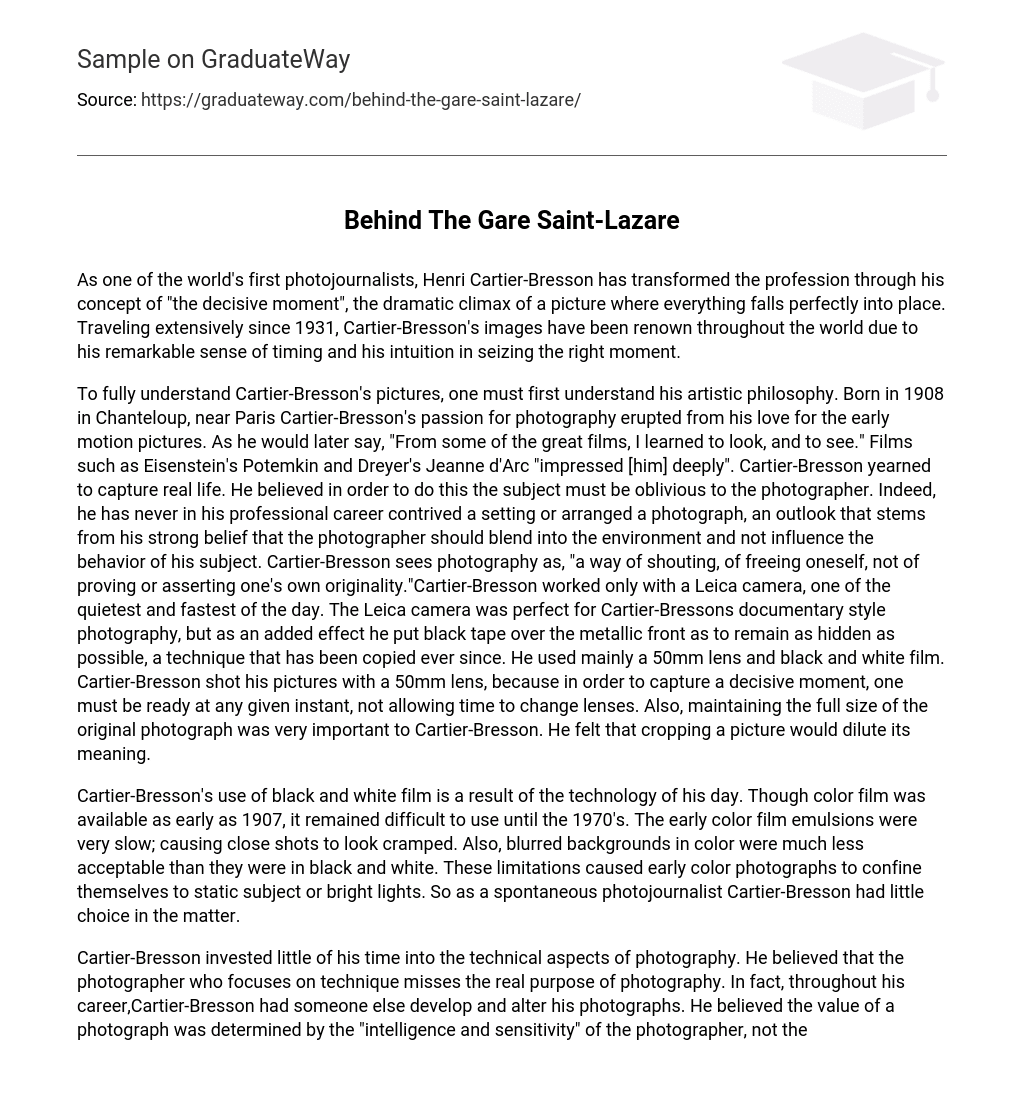As one of the world’s first photojournalists, Henri Cartier-Bresson has transformed the profession through his concept of “the decisive moment”, the dramatic climax of a picture where everything falls perfectly into place. Traveling extensively since 1931, Cartier-Bresson’s images have been renown throughout the world due to his remarkable sense of timing and his intuition in seizing the right moment.
To fully understand Cartier-Bresson’s pictures, one must first understand his artistic philosophy. Born in 1908 in Chanteloup, near Paris Cartier-Bresson’s passion for photography erupted from his love for the early motion pictures. As he would later say, “From some of the great films, I learned to look, and to see.” Films such as Eisenstein’s Potemkin and Dreyer’s Jeanne d’Arc “impressed [him] deeply”. Cartier-Bresson yearned to capture real life. He believed in order to do this the subject must be oblivious to the photographer. Indeed, he has never in his professional career contrived a setting or arranged a photograph, an outlook that stems from his strong belief that the photographer should blend into the environment and not influence the behavior of his subject. Cartier-Bresson sees photography as, “a way of shouting, of freeing oneself, not of proving or asserting one’s own originality.”Cartier-Bresson worked only with a Leica camera, one of the quietest and fastest of the day. The Leica camera was perfect for Cartier-Bressons documentary style photography, but as an added effect he put black tape over the metallic front as to remain as hidden as possible, a technique that has been copied ever since. He used mainly a 50mm lens and black and white film. Cartier-Bresson shot his pictures with a 50mm lens, because in order to capture a decisive moment, one must be ready at any given instant, not allowing time to change lenses. Also, maintaining the full size of the original photograph was very important to Cartier-Bresson. He felt that cropping a picture would dilute its meaning.
Cartier-Bresson’s use of black and white film is a result of the technology of his day. Though color film was available as early as 1907, it remained difficult to use until the 1970’s. The early color film emulsions were very slow; causing close shots to look cramped. Also, blurred backgrounds in color were much less acceptable than they were in black and white. These limitations caused early color photographs to confine themselves to static subject or bright lights. So as a spontaneous photojournalist Cartier-Bresson had little choice in the matter.
Cartier-Bresson invested little of his time into the technical aspects of photography. He believed that the photographer who focuses on technique misses the real purpose of photography. In fact, throughout his career,Cartier-Bresson had someone else develop and alter his photographs. He believed the value of a photograph was determined by the “intelligence and sensitivity” of the photographer, not the accuracy of the technique.
“Behind the Gare Saint Lazaire” remains his most famous picture. Taken in Paris in 1932, this picture exemplifies Cartier-Bresson’s use of the decisive moment and justifies his love for natural spontaneity. The vertical, black and white, close range, photograph is of a man who is blurred due to haste. Though it is not raining in the picture, we know it has been raining due to the reflective puddle that covers the ground. The area must be under renovation, due to the pile of rocks and the wheelbarrow in the background and the ladder and metal rings lying in the foreground. In the distance there is a man standing by the gate looking away from the camera towards train station, and beside him are several posters on the fence.
Apart from the obvious “decisive moment” of the man frozen in mid air about to cause a huge splash, there is a great and much more amusing inference, which can be gathered. In the background, there is a poster of a leaping dancer mimicking the man’s jump and the less obvious leaping of the clock hand, which is faintly seen above. The adjacent poster with the words RAILOWSKY announces a circus event, giving the picture a new symbolism. In this context, the leaping man becomes a graceful circus acrobat and the horizontal ladder and metal rings echoes those used in juggling and trapeze acts. Like that mirror reflection of the man in the water, this is a case of life imitating art and art imitating life. Since his customers are magazine editors, Cartier-Bresson’s audience varies with the magazine that publishes his work. Though most periodicals that would print photojournalism would probley contain a social element, such as National Geographic.
For me, “Behind the Gare Saint Lazare” represents the ever present, but often unnoticed humor in life. Hardly anyone, least of whom myself, could register in a fraction of a second the serendipitous coincidence of the man and the posters, not to mention trying to take a picture and getting the shot while the man was still in mid air. I think it is too easy to study the photograph and analyze it, without taking into account the miracle that the photo was taken at all. “Behind the Gare Saint Lazaire” is not a particularly beautiful photograph and the clarity is not as crisp as the technology of the day could have allowed, but the value of the subject matter makes these observations negligible. As Cartier-Bresson said, “Technique is important only insofar as you must master it in order to communicate what you see.” I think that what needs to be taken from this picture is an awareness that perhaps irony and humor are more present in our lives then we notice. Cartier-Bresson’s gift as a photographer is his ability to capture the emotion and irony of life that most people, the man standing in the background included, would miss.





